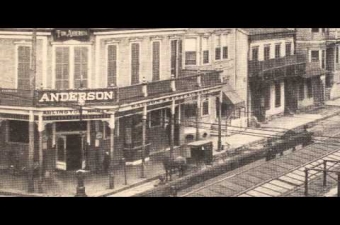Storyville
1300 Iberville St.New Orleans LA 70112
Storyville was the infamous red-light district behind the French Quarter, along Basin Street, between Canal Street and St. Louis Cemetery No. 1. It operated from 1897 until 1917,when, with World War I raging, the U.S. Navy forced the city to shut it down. Its name mockingly referred to city alderman Sidney Story, who sought to create the district to control and reform prostitution in New Orleans.
The District, as it was called, had a mixture of upscale brothels in mansions, such as Hilma Burt’s and Lulu White’s Mahogany Hall on Basin Street, cheaper brothels with prostitute “cribs” and “pads,” saloons, and dance halls on the back streets. The mansions employed parlor pianists, including Manuel Manetta and Jelly Roll Morton, to perform throughout the day and evening hours, while the saloons and dancehalls often hired ragtime dance bands to entertain patrons
The corner of Customhouse and Franklin (today’s Iberville and Crozat Streets) was home to several infamous bars. One of the best known, Big 25’s, featured early jazz musicians such as “Big Eye” Louis Nelson, Kid Ory, King Oliver, and Louis Armstrong. After closing time, they were known to have cutting contests to determine who was the best player. Nelson recalled:
“The sporting district come to have all the best musicians because the pay was every night. Just take the corner of Iberville and Franklin—four saloons on the four corners—the Big 25’s, 28, Pig Ankle, and Shoto’s. Those places had eight bands amongst them. Four on day and four on night. And they changes bands like you change underclothes.”
Two blocks up Iberville, away from the river, was Pete Lala’s saloon, which also featured the best musicians in town. Jelly Roll Morton recalled a pool game there:
“One day we were all up at Lala’s saloon. Pensacola Kid was playing Buster Brown for ten dollars a round and they asked me to keep the game. In came Chicken Dick, the Uptown roughneck, and started yelling…. He hit me hard and I fell on the table with my hands on some balls. I hauled off and hit him with a pool ball and he jumped like he was made of rubber…. They gave me a name. ‘Don’t fool with Winding Boy. He like to kill Chicken Dick.’ I had sense enough to know it wasn’t healthy to wear a name like that around New Orleans where some tough guy might decide to see how hard I really was. So I decided to accept Tony Jackson’s invitation to visit Chicago.”
The first jazz history book, Jazzmen, edited by Charles Edward Smith and Frederic Ramsey, characterized Storyville as the “birthplace of jazz.” This generalization, propagated by the 1947 film “New Orleans” starring Louis Armstrong and Billie Holiday, persists today. In fact, early New Orleans jazz evolved here and all over the city in a variety of venues and contexts, from society dance halls to lakefront picnics.
By 1940 most of the district had been leveled as part of a “slum clearance” project. The Iberville public housing development—which has its own musical legacy—went up in its place. The Iberville was demolished in 2013 as part of a new federal housing initiative, with construction ongoing four years later. Today, only three structures from Storyville are still standing. One, Frank Early’s My Place Saloon, is at the corner of Bienville and Crozat Street.
Videos

A five-minute overview of Storyville with Dr. Alecia Long of Louisiana State University, released in 2011.
From 2011, video by The Times-Picayune posted by
A five-minute overview of Storyville with Dr. Alecia Long of Louisiana State University, released in 2011.
Images









































